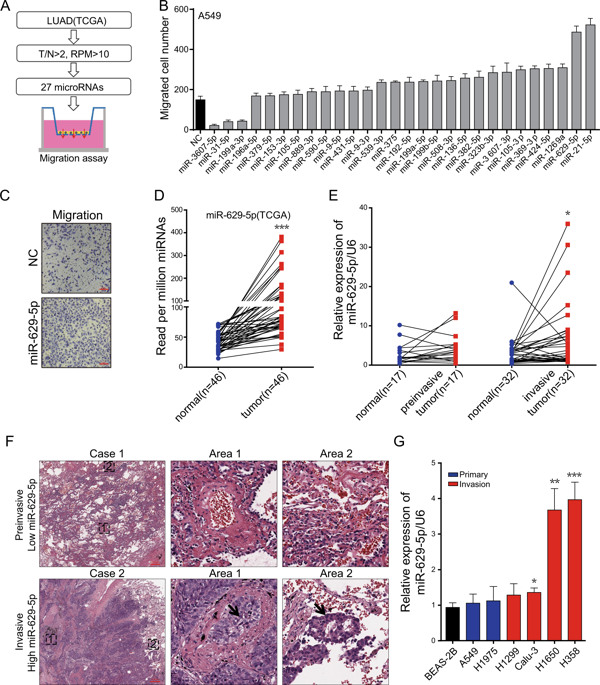Our official English website, www.x-mol.net, welcomes your
feedback! (Note: you will need to create a separate account there.)
MiR-629-5p promotes the invasion of lung adenocarcinoma via increasing both tumor cell invasion and endothelial cell permeability.
Oncogene ( IF 6.9 ) Pub Date : 2020-02-27 , DOI: 10.1038/s41388-020-1228-1 Yu Li 1, 2 , Huibiao Zhang 3 , Lei Fan 1, 2 , Jiahui Mou 1, 2 , Yue Yin 4 , Chao Peng 5 , Yuxiang Chen 1 , Henglei Lu 1, 6 , Liting Zhao 7 , Zhouteng Tao 1, 2 , Jing Chen 1, 2 , Yizheng Wang 8 , Xinming Qi 1, 2 , Ruimin Huang 2, 9 , Jin Ren 1, 2
Oncogene ( IF 6.9 ) Pub Date : 2020-02-27 , DOI: 10.1038/s41388-020-1228-1 Yu Li 1, 2 , Huibiao Zhang 3 , Lei Fan 1, 2 , Jiahui Mou 1, 2 , Yue Yin 4 , Chao Peng 5 , Yuxiang Chen 1 , Henglei Lu 1, 6 , Liting Zhao 7 , Zhouteng Tao 1, 2 , Jing Chen 1, 2 , Yizheng Wang 8 , Xinming Qi 1, 2 , Ruimin Huang 2, 9 , Jin Ren 1, 2
Affiliation

|
Tumor invasion underlies further metastasis, the leading cause for cancer-related deaths. Deregulation of microRNAs has been identified associated with the malignant behavior of various cancers, including lung adenocarcinoma (LUAD), the major subtype of lung cancer. Here, we showed the significantly positive correlation between miR-629-5p level and tumor invasion in LUAD specimens (n = 49). In a human LUAD metastasis mouse model, H1650 cells (high level of miR-629-5p) were more aggressive than A549 cells (low level of miR-629-5p) in vivo, including higher incidence of vascular invasion and pulmonary colonization. Ectopic expression of miR-629-5p in A549 cells also increased their invasive capability. Then we identified that miR-629-5p promotes LUAD invasion in a mode of dual regulation via tumor cells invasion and endothelial cells permeability, respectively. In tumor cells, miR-629-5p enhanced motility and invasiveness of tumor cells by directly targeting PPWD1 (a cyclophilin), which clinically related to tumor invasion in LUAD specimens. Restoring PPWD1 protein significantly attenuated the invasion-promoting effects of miR-629-5p. Besides, exosomal-miR-629-5p secreted from tumor cells could be transferred to endothelial cells and increased endothelial monolayers permeability by suppressing CELSR1 (a nonclassic-type cadherin), which had a low level in the endothelial cells of invasive LUAD specimens. Activating the expression of CELSR1 in endothelial cells markedly blocked the effect of miR-629-5p. Our study suggests the dual roles of miR-629-5p in tumor cells and endothelial cells for LUAD invasion, implying a therapeutic option to targeting miR-629-5p using the "one stone, two birds" strategy in LUAD.
中文翻译:

MiR-629-5p通过增加肿瘤细胞侵袭和内皮细胞通透性来促进肺腺癌的侵袭。
肿瘤浸润是进一步转移的基础,而转移是癌症相关死亡的主要原因。microRNA的失调已被确定与多种癌症的恶性行为有关,包括肺癌的主要亚型-肺腺癌(LUAD)。在这里,我们显示了miR-629-5p水平与LUAD标本中的肿瘤浸润之间显着正相关(n = 49)。在人类LUAD转移小鼠模型中,体内的H1650细胞(高水平的miR-629-5p)比A549细胞(低水平的miR-629-5p)更具侵略性,包括更高的血管侵袭和肺部定植率。miR-629-5p在A549细胞中异位表达也增加了其侵袭能力。然后我们发现miR-629-5p通过肿瘤细胞侵袭和内皮细胞通透性双重调控模式促进LUAD侵袭,分别。在肿瘤细胞中,miR-629-5p通过直接靶向PPWD1(亲环蛋白)来增强肿瘤细胞的运动性和侵袭性,而PPWD1在临床上与LUAD标本中的肿瘤侵袭有关。恢复PPWD1蛋白可显着减弱miR-629-5p的侵袭促进作用。此外,肿瘤细胞分泌的外泌体miR-629-5p可通过抑制CELSR1(非经典型钙黏着蛋白)转移到内皮细胞并增加内皮单层通透性,而CELSR1在侵袭性LUAD标本的内皮细胞中水平较低。激活内皮细胞中的CELSR1的表达明显阻断了miR-629-5p的作用。我们的研究表明,miR-629-5p在肿瘤细胞和内皮细胞中对LUAD侵袭具有双重作用,这意味着使用“一块石头,
更新日期:2020-02-28
中文翻译:

MiR-629-5p通过增加肿瘤细胞侵袭和内皮细胞通透性来促进肺腺癌的侵袭。
肿瘤浸润是进一步转移的基础,而转移是癌症相关死亡的主要原因。microRNA的失调已被确定与多种癌症的恶性行为有关,包括肺癌的主要亚型-肺腺癌(LUAD)。在这里,我们显示了miR-629-5p水平与LUAD标本中的肿瘤浸润之间显着正相关(n = 49)。在人类LUAD转移小鼠模型中,体内的H1650细胞(高水平的miR-629-5p)比A549细胞(低水平的miR-629-5p)更具侵略性,包括更高的血管侵袭和肺部定植率。miR-629-5p在A549细胞中异位表达也增加了其侵袭能力。然后我们发现miR-629-5p通过肿瘤细胞侵袭和内皮细胞通透性双重调控模式促进LUAD侵袭,分别。在肿瘤细胞中,miR-629-5p通过直接靶向PPWD1(亲环蛋白)来增强肿瘤细胞的运动性和侵袭性,而PPWD1在临床上与LUAD标本中的肿瘤侵袭有关。恢复PPWD1蛋白可显着减弱miR-629-5p的侵袭促进作用。此外,肿瘤细胞分泌的外泌体miR-629-5p可通过抑制CELSR1(非经典型钙黏着蛋白)转移到内皮细胞并增加内皮单层通透性,而CELSR1在侵袭性LUAD标本的内皮细胞中水平较低。激活内皮细胞中的CELSR1的表达明显阻断了miR-629-5p的作用。我们的研究表明,miR-629-5p在肿瘤细胞和内皮细胞中对LUAD侵袭具有双重作用,这意味着使用“一块石头,










































 京公网安备 11010802027423号
京公网安备 11010802027423号